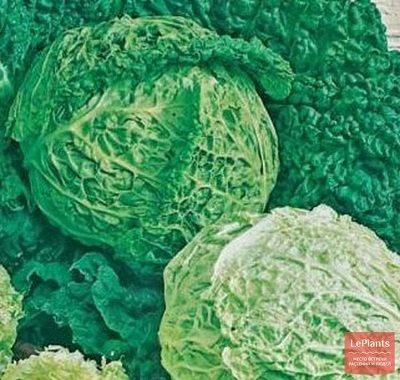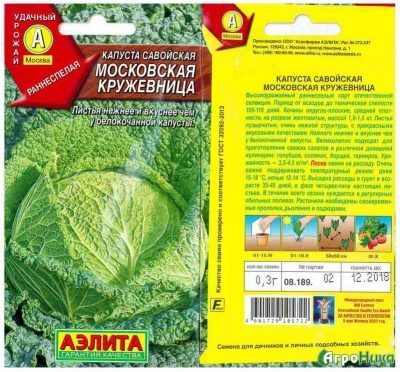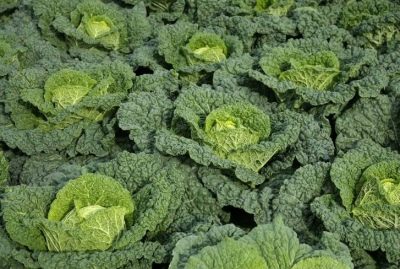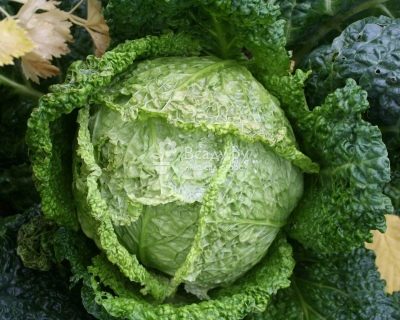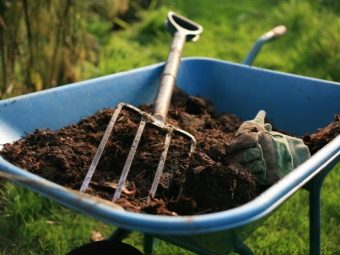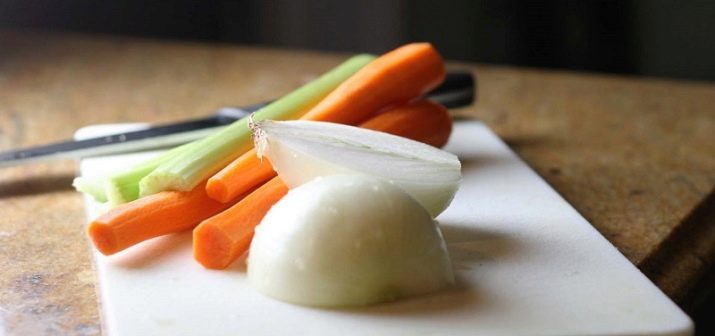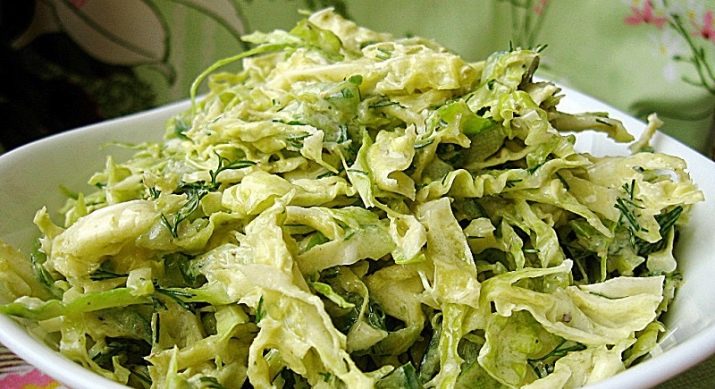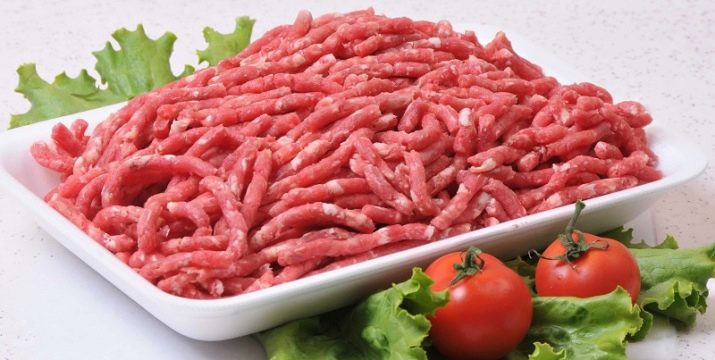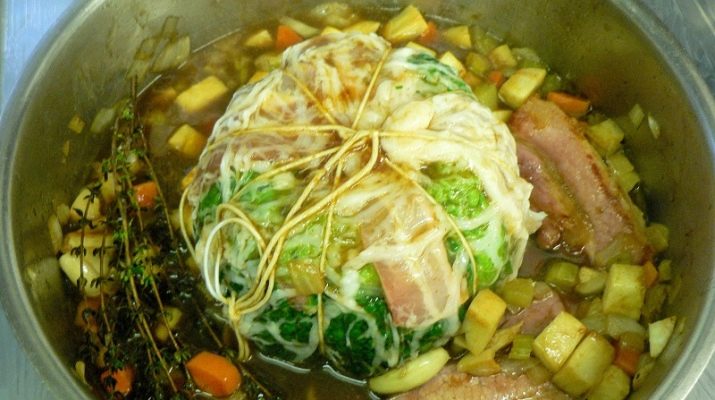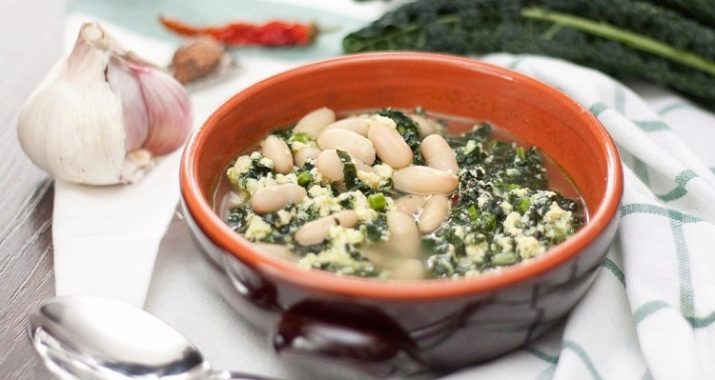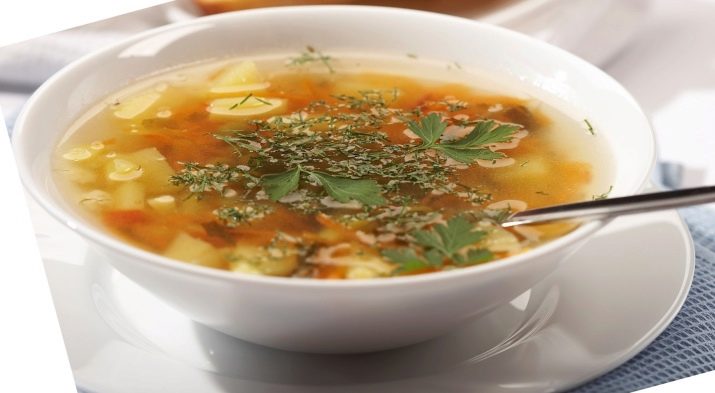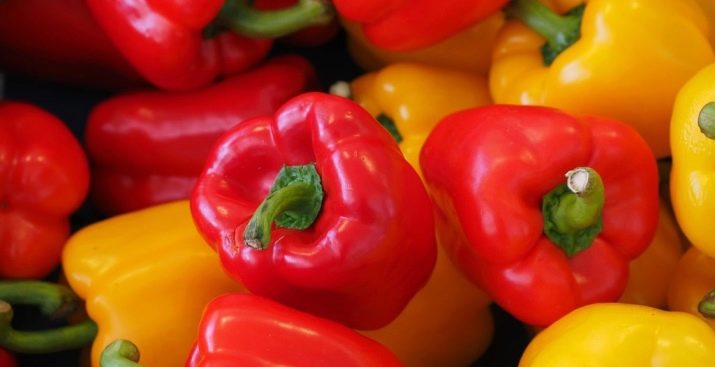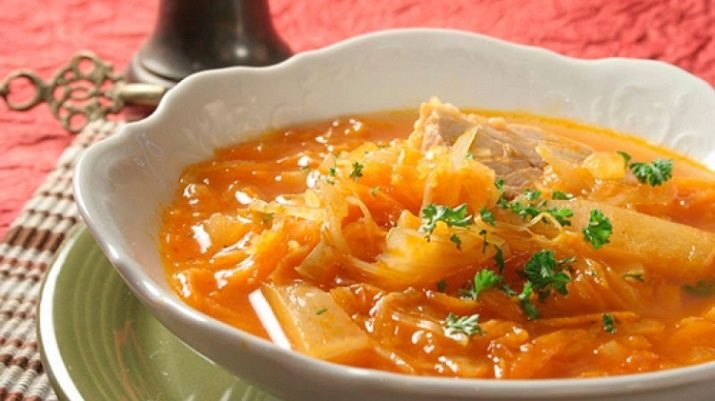Savoy cabbage: features and varieties, planting and care, tips on storage and use
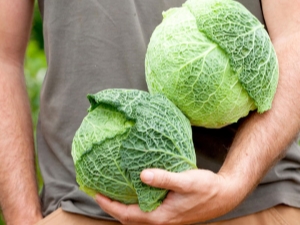
Gardeners around the world are constantly looking for new crops.So, today in Russia savoy cabbage is gaining popularity. Possessing an interesting appearance and excellent taste properties, it is a worthy alternative to cabbage.
Description of vegetable culture
Savoy cabbage has a deep history. As early as the 17th century, in the small duchy of Savoie, she was very fond of not only the common people, but also the French king Louis XIV. Brought her royal gardener, who a little later the king granted the greatest award for those times - the title of nobility with the coat of arms. The coat of arms itself depicted three heads of cabbage with crossed shovels.
It should be noted that cabbage is still very popular in Europe. An annual tradition for the Italian town of Udina is holding a holiday in honor of this vegetable, where you can taste thousands of dishes with its participation. Surprisingly, even tourists from Russia, having visited European restaurants, note the special tenderness and lightness of vegetable side dishes and salads with cabbage. The point here, of course, is not the great and massive skill of cooks, but the use of culture from distant Savoy.
So, Savoy relative of our native cabbage has a very interesting appearance, which differs from the white cabbage. Its characteristic features are:
- loose head;
- corrugated leaves without large veins;
- the softness and tenderness of each leaf;
- color depending on the variety varies from light green to dark green.
In addition, a foreign vegetable has an odor unusual for cabbage cultures, does not emit a specific smell when boiling and stewing.
The main differences between the two cultures is the vitamin and mineral compositions, which in the vegetable from Savoy are much more enriched. So, in the succulent leaves are thiamine, vitamins C and B12, protein, fiber, iron, magnesium, zinc and other components of the periodic table, as well as pectin, beta-carotene and many other useful substances.
It should be noted that the caloric content of such a product is only 28.2 kcal per 100 grams, which means it can be eaten practically in unlimited quantities.
Beneficial features
As mentioned earlier, cabbage of this type has in its arsenal a rich storehouse of vitamins and minerals, which, with regular consumption, heals the human body. Due to the presence in the composition of glutathione, you can prolong youth, slowing down cell aging, as well as enhance immunity and protect yourself from the harmful effects of carcinogens, which are constantly present in modern food and life. In addition, savoy cabbage is a natural antidepressant, and therefore it is very useful for increased excitability, emotionality and frequent stress. Provides such effects all the same glutathian in tandem with vitamin B.
The benefits of eating vegetables do not end there, but are only revealed from the new side. For example, it helps cleanse the liver of toxins, prevent the growth of cancer cells and prevent the conversion of carbohydrates into fat mass. Due to its lightness, cabbage is quickly absorbed in the body, normalizing digestion. It improves blood circulation and is a popular doctor in the prevention of cardiovascular diseases. The product is shown to children, adults and elderly people.
It should be noted that this vegetable crop is useful not only as a gastronomic pleasure. Adherents of traditional medicine often squeeze the juice from the tender and juicy leaves, preparing from it the most useful decoctions.
Juice becomes an assistant when:
- peptic ulcer diseases;
- stomatitis;
- periodontal disease;
- angina;
- hangover syndrome.
Every ailment requires a strict dosage of juice. For example, in case of oral diseases, only a 1: 1 solution of healing liquid with water is used for rinsing.
Contraindications
Unfortunately, today there is hardly a product that will fit absolutely everyone and heal everyone’s body. This also applies to cabbage from Savoy, the use of which in fresh form should be avoided with diseases such as:
- pancreatitis;
- gastritis;
- aggravations associated with the violation of the gastrointestinal tract;
- disruption of the thyroid gland.
In addition, it is worth while to abandon the product after operations, especially if they concern the thoracic and abdominal sections. The harm from its use may be great.
Interestingly, about the cabbage family for a long time conducted studies on the subject of their harmful to the body. For example, it is scientifically established that a vegetable contains goitrogens, which can lead to a deficiency of thyroid hormones, but only in cases where:
- cabbage becomes a daily meal in the diet and makes up most of it;
- the body suffers from an acute iodine deficiency;
- the body gets an excess of calcium and fluoride.
Thus, it can be said with confidence that moderate consumption of a product is not capable of worsening the general condition of a person. However, knowing the characteristics of the organism, it is better to boil the vegetable before tasting or to use it in a stewed form. It is wiser to refuse altogether fried foods, because thin leaves can absorb a huge amount of fat, which is unable to digest even in a healthy person’s body.
Sorta
Savoy cabbage varieties are numerous and, very nicely, suitable for our climate and planting in open ground. When deciding whether to choose early or late varieties, it is worth remembering that the sowing work for early species will have to begin from mid-March, and in other cases from mid-April. Harvesting will also take on different months. Thus, it is possible to feast on ripe leaves either at the end of summer or in the middle of autumn, depending on the category to which the variety belongs.
Tightening with collections is not recommended, because technically ripe forks quickly crack, which significantly reduces their shelf life.
Early
Despite the fact that the cabbage of this species is still a novelty to many Russians, the gardeners, engaged in its cultivation, have already identified the best varieties. For example, numerous positive reviews about the Vienna Early vegetable crop make it one of the most worthwhile. "Vienna early" differs strongly corrugated leaves. Its color is rich and deep in dark green. Each full-length fork weighs about 1 kg on average.
“Early Gold” is another variety selected by gardeners. Despite the fact that the average weight of the head is lower than the “Vienna Early” by 200 grams, this culture is resistant to cracking, which allows to significantly extend its shelf life. It is worth noting that the maturation period is only 95 days. However, it is hardly possible to find a worthy competitor in the quickness and precocity of the early varieties “Komparsa” and “Melissa”. Counting 80 days from the date of landing in open ground, you can gladly collect a good harvest. It is worth noting that the weight of forks "Melissa" on average reaches 2-4 kg. However, they are stored poorly and are suitable only for seasonal consumption.
Vertus cabbage boasts good shelf life and transportation. Its large cabbages weighing 3 kg differ in density and evenness unusual for the species. The culture of the “World” is also good for disembarking and will please gardeners with large forks, reaching 1.5 kg. In addition, large heads of cabbage are resistant to cracking, and therefore you can truly enjoy the variety on your site.
Cabbage "Jubilee" does not occupy a leading position, although it belongs to quite early varieties, the crop from which can be obtained already in 85-110 days from the moment of disembarkation in open ground. A significant disadvantage of culture is the tendency to cracking and the impossibility of storage. "Jubilee" is suitable exclusively for the preparation of vitamin dishes in the season. However, the variety is well suited for Siberia with its short summer, and therefore is considered one of the most popular.
"Petrovna" - a variety characterized by good fertility. Despite the small forks weighing about 1 kg, with proper care it can be collected up to 5 kg per square meter.
One of the most interesting forms has cabbage with the funny name "Pie". Cone-shaped cabbages with dark green leaves have frost resistance, which allows the variety to be considered one of the suitable for planting in cold regions of Russia, as well as for the middle belt.
Regarding the new crop, registered only in 2013, is the cabbage "Nyusha". With its fine foliage, it has excellent taste properties.
Another crop with succulent leaves is considered to be the Moscow-laced cabbage. The weight of each fork reaches no more than 1 kg, however, it can rightfully be an ornament to any garden.
It should be noted that the gardeners of the Moscow region prefer early varieties. Frequent changes in weather conditions do not affect the early cabbage and its yield.
Late
Late varieties have a special frost resistance, and therefore, despite the long maturity, they become a frequent neighbor to other crops in domestic gardens.
“Vertu” is a vegetable crop that is well tolerated by moisture. The ripening period reaches 155 days, but the fruits are tied together, giving a good harvest. A distinctive feature can be considered dense cabbages. It is worth noting that it is “Vertyu” that many positive reviews of gardeners are devoted to.
The same maturity has a culture of "Nadia". Its soft and tender leaves are pleasing with good taste characteristics and are well transported, although they do not withstand long-term storage.
The Uralochka variety is distinguished by its light green leaves and yellowish slit. Its taste can be estimated as early as 100 days after transplanting, the ripening period of which occurs for 55 days. The harvest from “Uralochka” is collected in the middle of October, as the variety is unpretentious and frost-resistant.
A variety bred specifically for Siberia and the Ural region with the beautiful name “Vologda laces” is capable of pleasing high yields, despite the weather conditions. Dense and rounded head is the best for risky farming, being resistant to cracking.
“Alaska” is another late ripe culture. Its gray-green leaves with a waxy bloom form large heads of cabbage, characterized by an average weight of 2-3 kg. The advantages of the variety include its long-term preservation.
After 140-150 days, such late-ripening appearance as “Winter delicacy” is ready for consumption. Fruits, unlike other varieties, delight not only the richness of greenery, but also a reddish color. A good cold-resistant type has excellent taste and pleases with its juiciness and fresh tenderness.
Medium late cabbage "Cabbage" pleases harvest for 140 day planting. Its average weight reaches two kilograms with a good fecundity equal to 5-6 kg per square meter. "Stuffed cabbage" can be stored for 2-3 months without losing the presentable appearance and excellent taste.
Despite the abundance of varieties, Savoy cabbage is unlikely to displace the white relative. Small shelf life and the inability to prepare pickles makes it alien to many Russians.
Growing up
In most cases, planting Savoy cabbage for gardeners takes place in two stages. In mid-March, they are engaged in planting early varieties, in mid-April - late ones. As a rule, seeds are grown in specially prepared greenhouses or at home. The combination of early and late species allows you to fill your body with valuable vitamins from late summer to winter.
Agrotechnics and the rules of planting vegetables are not much different from the cultivation of the white species. In order to plant properly any variety of a given crop, attention should be paid to the seeds.As experienced gardeners note, many cabbage diseases can be prevented at the stage of their disinfection. So, it is recommended to cleanse the seeds even from well-known manufacturers, because this procedure is quite simple. The material that will need to be sown on seedlings, first immersed for 1-3 hours in hot water with an average temperature of 50 degrees, then for 3 minutes - in the cold. To make such a procedure is best, wrapping seeds with gauze.
Additional processing of seeds is their daily soaking in cool water with a temperature of two degrees. This will help grow a high-quality frost-resistant culture that can sprout for three years.
After preparing the seeds, you can do the soil in which you plan to sow seedlings. The main participant here is peat, which should occupy 80% of the total amount of soil. It is also worth remembering that the earth should be soft, not differing in this looseness.
In addition to peat, attention should be paid to the presence of a small amount of sand and sod land equal to a percentage of 20. Compost is a good fertilizer. Fresh manure is prohibited, as well as not recommended to bring land from the garden, being careful of the presence of numerous harmful organisms. Each kilogram of prepared soil is reasonably fertilized with a spoon of ash, providing not only comfortable conditions for the seedlings, but also good protection against the black-leg disease that is terrible for cabbage.
It is worth noting that the correct sowing of seedlings will not be able to provide excellent fruits in the future if all the rules of planting sprouts in open ground are not taken into account. However, strict adherence to the recommendations regarding the seeds and their planting will allow to obtain seedlings corresponding to the declared variety.
So, sowing is carried out in containers or individual glasses, specially designed for proper seating. The depth should reach one centimeter. Deeper plantings, as a rule, lead to rare shoots or even loss of culture. Seeds should be planted in several stages with a difference of 4 days. Already on the 5th day of daily watering, you can see the first shoots, the distance between which should be 2 cm. With more frequent planting, they must be thinned.
After the seeds give the first shoots, they continue to be watered, but the care of the cabbage does not end there. So, one of the most important conditions is a long light day, averaging 15 hours. With such a task is able to cope with an ordinary fluorescent lamp. Watering should be carried out qualitatively, because the culture loves moisture. It should be remembered that the stagnation of water can lead to suppuration, which will bring all work to naught during the day.
The first week in the general container should end for seedlings by picking into separate pots or cassettes. For this, the seedlings go deeper into the cotyledons, and the distance between the sprouts reaches 3 cm. It is necessary to engage in such painstaking work only with healthy seedlings that have no more than 5 strong leaves. Weak sprouts are discarded.
Seedlings will grow in pots to reach 15-20 cm in length. At the same time a week before landing in open ground it should begin to harden. The first procedures are considered daily ventilation of the room for about three hours. Two days before planting, the seedlings are transferred to the street, where they take care of them before landing on the site.
Planting seedlings in open ground should be after preliminary preparation. It should be noted that arable work should be carried out in the fall. Soft soil, fertilized with manure or compost - this is the best soil for the culture of Savoy. A favorable place is considered to be a plot of land remaining after the cultivation of legumes and grain crops.
The foreign vegetable does not accept beds, and therefore the area for planting it looks like a chessboard with holes, located at a distance of about 35-40 cm from each other. Their depth should coincide with the capacity in which the seedlings will be planted. Before planting, a liter of water is poured into each well.
Planted seedlings are beginning to get used to new conditions and, as a result, get sick. At this important time for her, it is recommended to shade the sunny area, and also to ensure good watering, loosening and fertilizing. Watering the vegetable should be at the root, especially when the head has already started. Otherwise, its friability and porosity will be excellent conditions for the life of slugs.
To seedlings gave a good harvest and ripening was observed, it should be carefully fertilized throughout the growth of the vegetable. So, a teaspoon of ash and urea should go into the wells already before planting. After 2-3 weeks, the soil is fertilized with mullein or urea. After another two weeks, the vegetable is fed with two tablespoons of NPK diluted in 10 liters of water. A striking indicator of vitamin deficiencies are the lower yellow leaves with dry edges.
How to store?
The rich harvest of varieties "Komparsa" and "Melissa" begin to gather in June, while the later varieties are removed from the site until the first frost. This solution provides longer storage.
Nevertheless, it is difficult to compare Savoy cabbage with white cabbage by shelf life, because in the first case they reach only 3 months from the moment of harvest. Carefully placing the forks on the open shelves and drawers in a row, you can monitor possible damage to the crop and quickly isolate diseased cabbages from healthy fruits. Comfortable for preservation is considered the temperature from -1 to -3 degrees.
Gardeners are advised not to delay storage, as thousands of seasonal dishes with cabbage from Savoy are ready to please the household all season.
Popular dishes
The leaves of the Savoy vegetable are tasty and tender, and therefore cooks and housewives from around the world are developing new recipes for their use.
Cabbage rolls
The most popular dish, beloved by Russians, are cabbage rolls from this cabbage variety. They love them in such a performance for simplicity. Unlike white-leaf varieties, the Savoy leaves without veins practically do not break, which facilitates folding and also surprises with its subtlety. To cook delicious cabbage rolls, you will need:
- cabbage - 2 heads;
- carrot - 2 pieces;
- rice cereal - 2 glasses;
- onion - 4 pcs;
- tomato paste - 1 cup;
- minced meat of any kind of meat - 1.5 kg;
- garlic, spices, bay leaf - to taste;
- sunflower oil for frying.
The first step is harvesting vegetables. Onions and grated carrots are fried until golden brown. While frying is cooked, the cabbage forks, after removing the head of cabbage, are immersed for five minutes in boiling water to completely soften the leaves. Cabbage should cool down a bit for comfortable work with it.
The next stage is rice preparation. It is boiled in a separate container until half ready. Such a nuance will subsequently help absorb the undercooked cereal taste of meat.
Cooking minced start with chopping and adding garlic to it, as well as most of the roasting and spices. The raw, fragrant mixture is mixed with undercooked rice and wrapped in neat envelopes of leaves separated from the fork.
Ready for further action, cabbage rolls are tightly loaded into a saucepan or bowl of a slow cooker. Lay them must be tight, pouring a mixture of tomato paste and the remaining roasting.
The dish is brought to a boil, and then stewed over low heat for about an hour and a half. At the same time it is important to monitor the amount of fluid and top up if necessary. Hot and fragrant cabbage rolls served on the table with greens.
Snack
As mentioned earlier, savoy cabbage is not subject to fermentation and other manipulations due to its low preservation.However, this does not prevent the housewives from preparing delicious snacks that can stay fresh for two months.
Ingredients required snacks:
- cabbage - 2 kg;
- vinegar - 0.6 l;
- sugar - half a glass;
- water - 2 liters;
- black pepper;
- salt - 1 cup.
Forks are finely chopped and frayed with ¼ cup of salt. The finished straw is tamped into a jar and left in a cold place for several hours. Next, prepare the marinade, boiling water and adding there the remains of salt and sugar. It is necessary to pour in 9% vinegar and cool the liquid. After several hours in the cold, the straw is taken out of the jar and the juice is carefully squeezed out. Putting the cabbage in the jar again, it is poured with a cold marinade, and then closed with a plastic cap.
Stuffed Forks
You can cook cabbage from Savoy in various ways, for example, you can try stuffed forks as a luxurious dish. Components for stuffed forks:
- cabbage - 1 kg;
- minced meat - 0.5 kg;
- bacon - a few thin slices;
- carrots - 1 pc;
- onion - 3 pcs;
- milk - 100 ml;
- egg - 1 pc;
- greens, garlic - to taste;
- spice;
- white bread or long loaf - 2 pieces.
Cooking should start with a boiling fork. To do this, it is cut crosswise in a stalk, moving apart the leaves. In the pan forks laid head down, then pour water. Cooking time - 1 hour.
For the mince, you need to soak the bread without a crust in milk. After that, chop all the vegetables with the exception of 1 onion and mix thoroughly with minced meat, finely chopped bacon and egg.
When the preparation of the filling is completed, the forks are removed from the cabbage broth and allowed to cool. After that, they begin to carefully remove the leaves from the head. Each gap is filled with minced meat. Ready forks wrapped with gauze, tied with thread and immersed in vegetable water with the addition of the remaining onions and carrots. After boiling, the cooking time is 1 hour.
It should be noted that it is possible to prepare quite simple dishes from this vegetable, which can be a salvation for the extraordinary treat of guests. This category includes a light salad with crab sticks.
Salad with crab sticks
Ingredients:
- cabbage - ¼ fork;
- sticks - 180 grams;
- sweet canned corn - 1 jar;
- eggs - 3 pieces;
- fresh cucumbers - 2 pcs;
- mayonnaise.
Eggs must be boiled and finely chopped. Also, all other components are subject to cutting with the exception of corn. The prepared ingredients are mixed and supplemented with mayonnaise.
Tuscan Bean Soup
You can also make a delicious Tuscan bean soup from cabbage.
Components:
- cabbage - ¼ medium fork;
- canned tomatoes - 800 grams;
- canned washed beans (white) - 400 grams;
- olive oil;
- salt, pepper - to taste.
Tomatoes must be placed in a large saucepan, pour 500 ml of water and let boil. Add chopped cabbage to fragrant broth for 15 minutes. Leaves should be soft. After cooking in the soup, you must send the beans for a few minutes, then add the spices to taste. Serve soup is recommended with a spoon of olive oil.
Shchi
For a more substantial dinner, excellent soup with the use of tender leaflets of vegetable is suitable as a main dish. Ingredients Required:
- pork meat - 1 kg;
- 6 large potatoes;
- carrot - 1 pc;
- onion - 1 pc;
- celery - 2 pieces;
- cabbage is half the middle fork;
- tomato - 1 pc;
- in front of the Bulgarian - 1 pc;
- salt, spices, herbs - to taste.
To prepare the broth in the water, you must put pork, salt, remove the foam after boiling and cook for an hour in tandem with roasted carrots, onions and tomatoes. Finished meat should be laid out of the broth and cut into portions, then dipped again in water.
After the main vegetables are cooked, chopped forks and Bulgarian pepper are added to the soup. 10-15 minutes of simmering over low heat should soften the leaves and signal the cooking of the soup.The last ingredients are shredded herbs and spices.
Lenten soup
It should be noted that the dish is as good and without meat. Lenten cabbage soup from Savoy cabbage is indispensable for the children's table and treats in the post.
Components:
- 1 cabbage forks;
- carrot - 1 pc;
- onion - 1 pc;
- Bulgarian pepper - 1 pc;
- 3 potatoes;
- water -2.5 liters;
- a mixture of peppers;
- salt;
- greenery;
- Bay leaf.
For the first dish to be enriched with a richer and brighter taste, roasts are prepared from carrots and onions. After 5 minutes of frying, add shredded peppers and a clove of garlic. For the children's table, this step can be skipped, dispensing with the use of sunflower oil.
We put water on the fire and add potatoes to it. You can cut it into cubes or straws, depending on subjective taste preferences. After 5 minutes, the potatoes can be supplemented with toasting and fragrant bay leaves, which is important not to forget to remove after 10 minutes of cooking.
The final ingredient is shredded cabbage, which takes 10-15 minutes to cook. Next, the readiness of the soup is determined by the softness of the potato. The finished flavored broth is covered with a lid and allowed to brew, thereby achieving a homogeneous taste.
As a sauce and zest for lean soup fit a mixture of sour cream with finely chopped greens, which must be laid out in each plate in portions.
Summarizing the above, it is worth noting that the first and second courses, salads and savoy cabbage snacks pleasantly surprise with their diversity. Its delicate taste harmoniously exists in the cuisines of various countries, in dishes of various categories, which means you should look at it more closely.
In the next video you will find a recipe for a delicious savoy cabbage casserole.











